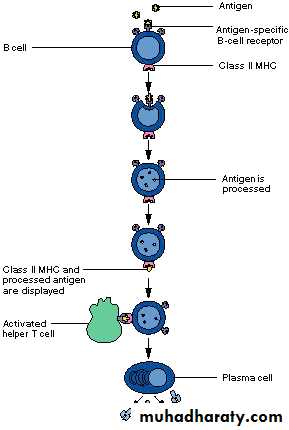B lymphocytesDr. Nada A Hasso
B lymphocytesB cells are derived from pluripotent haematopoietic stem cells under the effect of stimulating colony factor ( SCF)
They develop in the bone marrow( BM) throughout the life of an individual.
Functions of B-cells:
Chief cell type in humoral immunity, they produce antibodies
Function as Ag Presenting Cells.
Secrete lymphokines & other factors that influence the growth and activities of other immunologically important cells.
Anatomical distribution of B cell population
The early phase of B cell differentiation takes place in the BM ( Ag-independent phase)Mature B cells circulate through blood to secondary lymphoid organs mainly lymph nodes, spleen and mucosa-associated lymphoid tissue (MALT).
B cells interact mostly with Ags (Ag–dependent phase) in the lymphoid organ where a germinal center (GC) is formed which is a site of further proliferation and differentiation.
B cells that interact with Ags in the blood, they go to the spleen.
B- cells development
Ag- independent phase:In the bone marrow, B- cells mature from lymphocyte stem cells into pro B-cell, early pre B-cells, late pre B-cells, immature B-cells to end into mature B-cells.
B- cells education
The B cells are educated in the BM to recognize the self- HLA molecules. The cells which cannot recognize self antigens are deleted by apoptosis (positive and negative selection).
B-cell development
Cont,
B cell markers
B cells acquire molecules on their surfaces called cell markers which have been studied thoroughly by monoclonal antibodies (McAbs).B cells express several different CD antigens that can be used to distinguish B cells from other cells.
CD19 is expressed on all B cells ( Pan B cell marker) (except fully mature plasma cells).
However, the expression of some of these antigens changes with the developmental stages of B cell.
Cont,
Human tumor of B cells are corresponding to all stages of B cell development.Example, common acute lymphoblastic leukemia is a malignant of pro-B cells, the markers of the tumor cells are CD10(+) & CD19(+) which are comparable to that of normal pro- B cells.
Mature B-cells
The mature B cells have the following markers: CD 19, CD20, CD22, CD23, CD40, CD32, CD72 and MHC class I and II.Mature B-cells express sIgM and sIgD which are the B cells receptors for antigens (BCR).
These cells represent about 15% of the peripheral lymphocytes and are present in the primary lymphoid follicles , mantle zone of secondary follicles of LN, and white pulp (marginal zone & germinal centre) in the spleen.
Activation of B cells
Most of the B cells depend on T cells in their activation( T-cell dependent Ag)
The B-T cells co-operation occurs according to the following:• Intimate contact between B & T cells after the B cells recognize an antigen by binding to the BCR.
• The antigen is internalized, then re-expressed in combination with HLA class II (Ag + HLA-II).
Cont,
• This will be recognized by CD4 (T-helper cells). The B-T contact is mediated by:a. MHC II + Ag on B-cells with TCR + CD4 on T cells
b. CD80 or B7 on B cells combines with CD28 on T cells.
c. CD40 on B cells combines with CD40L (L= ligand) on T- cells.
d. ICAM-1 on B cells and LFA-1 on T cells.
e. LFA - 3 on B cells and CD2 on T cells.
T-B cells Cooperation
T-B cell Cooperation
Cont,
2. Release of appropriate cytokines from activated T-cells.Th1 controls the production of IgM & IgG2, while Th2 controls the production of IgE & IgG1.
Differentiation of activated B cells into plasma cells
B cells activated by interaction with helper T cells will divide forming B lymphoblasts in the germinal center.Then these cells become large metabolically active cells called centroblast and then centrocytes ( both are GC cells).
Then these cells migrate towards the medulla and become plasma cells.
They are the Ab secreting effector cells of B lymphocytes, they are characterized by a high rate of protein synthesis due to Ab production. Plasma cells can secrete 2000 molecules per second and may die within 3-10 days.
Some of the plasma cells have the ability to home to the bone marrow where they continue to secrete antibodies for months or years after the antigen is no longer present.
Memory B cells
They are formed from activated B cells that are specific to the antigen encountered during the primary immune response.They are very long-lived and can respond quickly following a second exposure to the same antigen by production of high affinity antibodies mainly of IgG type.
Memory B cells can express IgG, IgE & IgA on their surfaces.




